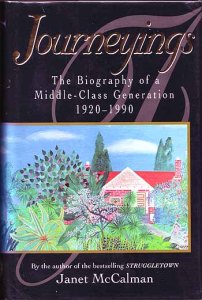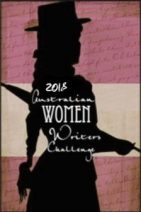
1993, 301p. & notes
This book opens with the No. 69 tram travelling from Carlisle Street St. Kilda to Cotham Rd Kew on the first day of school, 1934. The tram wends its way “along the spine of Melbourne’s middle-class heartland”, with an ebb and flow of private school students who peel off as they pass the major private schools in Melbourne. Being 1934, these are the children of WWI parents and unless they have scholarships, their parents are paying for their private school education during the Depression.
The No. 69 tram in February 1934 is the opening chapter and linchpin of Janet McCalman’s book, which explores both the antecedents and consequences of that daily commute. Starting in the years 1850-1919, her second chapter titled ‘Inheritances’ examines the social and economic origins of what was to become the Melbourne middle class of the 1930s, starting with the ‘Seekers and Saints’ who emigrated between 1850-1870 and embedded themselves as ‘The Greedy and the Good’ between 1879-1890. Chapter 3, ‘The Lessons of Innocence 1920-1939’ explores the inter-war years in which these young school children catch their tram in 1934, oblivious to the second ‘war to end all wars’ that faced them.
McCalman then follows through with this generation, examining their war-time experience in Chapter 4 ‘Coming of Age 1939-1945’ and their post-war family and work lives in ‘The Trials of Experience 1946-1966.’ Her chapter ‘Mid-Life Crisis 1967-1975’ captures the mid-career mindset of her middle-class informants in the midst of the world-wide disruption of 1968 and the political ferment of the ascension and dismissal of the Labor Party in Australia. Her final chapter ‘The Age of Wisdom 1976-1990’ takes her right up to the ‘Journeyings’ survey conducted in 1990 amongst the former students (pre 1950) of four private schools that were passed by the No 69 tram.
I must declare my own colours here. Even though in 1934 my father lived one block down from Glenferrie Rd, along which the No 69 tram rattled (i.e.the very years that McCalman uses in her opening image), I am proudly the product of a government school, as were my parents. I strongly oppose the social and educational distortions brought about by John Howard’s funding of private schools that no government seems to have the courage to dismantle. So I read this book with a jaundiced eye and certainly no sense of identification.
However , McCalman complicates my easy prejudices through her research. It is largely based on a 1990 survey that she conducted with Mark Peel that yielded 633 responses from pre-1950 school leavers from Scotch and Trinity, (both boys’ schools), Methodist Ladies College and Genazzano convent. There were 1235 surveys distributed, yielding a hefty 42% response rate. McCalman’s methodology combines prosopography, survey responses, oral history interviews with 80 respondents, the judicious use of fiction and memoir, her own literature review, and statistics.
Although solidly middle-class, the financial and social backgrounds were more varied than I expected for this 1934 cohort, based on statistics drawn from Scotch senior students in 1934 and MLC students born in 1919 and 1920. Going to a private school did not guarantee a high education level: 43% of the Trinity 1919-20 boys cohort left without the Intermediate Certificate (i.e. Yr 10), while 65% of the MLC cohort left without their Intermediate. In a rather anecdotal experiment, McCalman asked a group of retired senior teachers (who were themselves at secondary school in the 1930s and 1940s) to compare papers set for the external Intermediate, Leaving and Leaving Honours papers for 1935 and the examinations set for the Higher School Certificate (superseded in 1992). Their consensus was that in 1935 the emphasis was on clean and accurate work, which penalized misspellings, grammatical flaws and arithmetical slips. French and German was much more difficult in the 1930s but “in most of the other humanities, the intellectual demands of the 1930s papers were lower than would be acceptable by the 1960s.” (p. 123).
As McCalman traces through this 1930s cohort, she contextualizes them within Australia’s history. Because these four schools were denominational, there is an emphasis on spirituality. I was well aware of the Split of 1955 and the influence of the Movement within the Catholic church, but completely unaware of progressive Catholic activism (which was featured recently in History Workshop). Long before History of the Emotions became a historical ‘turn’, she focuses on hearts, souls, masculinity and femininity, minds and manners.
I like her discussion of fiction and history in her preface:
…because this is a group biography, a collection of stories of actual lives, it needs to unfold in the way real lives do- which is that none of us knows what lies ahead. Perhaps one of the most important functions of fiction is to permit us to escape that existential plight – it is a rehearsal for life; in writing history, however, we need to feel life’s dreadful unpredictability, its untidiness, its ordinariness, its splendours. Art is under our control; history, like life, is not. And yet history is but our reconstructions, is but an artefact of the mind, conceived of differently by all of us, and differently by all of us at different times in our lives… We are incorrigibly historical beings; our inner histories of ourselves- private history- constitute our ever-evolving sense of identity- we are our own stories. But in constructing histories – whether private or public- we are torn between what we would like the story to be and what the evidence insists that it really is. The novelist enjoys a licence; the historian a responsibility (p.viii)
Before writing Journeyings, McCalman had received acclaim for Struggletown: Public and Private Life in Richmond 1900-1965 which used a similar methodology in the working-class (although now gentrified) inner Melbourne suburb of Richmond. I have read Struggletown, but did not record my response to it at the time. The two books work well as a pair. Journeyings also complements Judith Brett’s Robert Menzies’ Forgotten People, which is cited often.
By the final chapter (1976-1990) her informants were mature retirees, with a remarkably low divorce rate and generally (but not exclusively) politically conservative. Perhaps it was my government-school-streak coming out here, but I found myself bridling at the smug moral superiority that came through many of their responses, the noblesse oblige and the disavowal of ‘old school tie’ networks when there was clear statistical evidence of its significance in ‘elite’ circles. What was McCalman going to do with this? Did she feel the same way as I do?
I think she did. Citing Sir Robert Menzies’ ‘The Forgotten People’ speech and Judith Brett’s analysis of it, McCalman writes:
Children who are educated apart behind high walls can find it difficult in later life to become at one with those on the other side. Children who are told endlessly by their parents and teachers that they are fortunate, privileged, special, inheritors and examples of excellence, will find it difficult to be good democrats. Even if they are imbued with a sense of service and care ‘for those less fortunate than themselves’, they can still find it difficult to feel simply as fellow Australians. (p.301)
This is an excellent book. It’s beautifully written, it is nuanced and yet broad. The No. 69 trope works so well.
And look at this: the Public Education Campaign has just released a video that answers back to that last chapter, too.
Sourced from: my very own bookshelves, where it has sat patiently for decades.
My rating: 9/10

I have recorded this review at the Australian Women Writers Challenge 2018

Oh, but there were renegades on the 69 tram route. We are not the sort of people who respond to surveys!
A great analysis. I spent my uni years with private school kids, due to Dad sending me to Trinity College (Melb Uni) and “smug” would be a perfect description. Dad’s parents who followed the Public Service down from Canberra, spent the war years in Hawthorn too (hence our football allegiance), but he went to Melb High – I forget where, as the army had the Melb High campus.
Such an interesting approach to history. Thanks for the astute review. I’ve wondered how closely the public/ private school divide determines lifelong Labor/ Liberal voters today.
Pingback: Australian Women Writers Challenge 2018 completed | The Resident Judge of Port Phillip
Pingback: Looking back: 2018 in review | The Resident Judge of Port Phillip